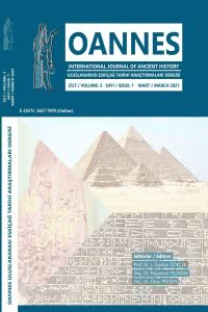Hititçe Çivi Yazılı Metinlerde GIŠ/GIKAK.Ú.TAG.GA
İnsanoğlunun kullandığı en eski silahlardan birisi olan ok, ilk başlarda avcılık için kullanılırken, zamanla bir savaş aleti olarak tarihteki yerini almıştır. Ok, birlikte kullanıldığı yay ile eskiçağ toplumlarının başlıca silahı olarak karşımıza çıkmıştır. Hitit ülkesinde de birçok savaş aleti kullanıldığını bilmekteyiz. Bu aletlerden birisi, Hititçe çivi yazılı metinlerde karşımıza çıkan GIŠ/GIKAK.Ú.TAG.GA’dır. “Ok” şeklinde tercüme ettiğimiz bu alet, çivi yazılı metinleri incelediğimizde, yalnızca savaş aleti olarak kullanılmamıştır. Bunun dışında, farklı türden metinlerde ve farklı kullanım şekilleriyle karşımıza çıkmıştır. Makalemizde, GIŠ/GIKAK.Ú.TAG.GA yani “ok” kelimesinin geçtiği metin yerlerini belgeleyerek, kelimenin işlevi ve kullanım amacı hakkında bilgi vermeye çalıştık.
GIŠ/GIKAK.Ú.TAG.GA In The Hittite Cuneiform Texts
Arrow, which is the most ancient weapon to be used by humankind, has been a war tool in time while it was used for hunting at first. Arrow became the main weapon in ancient era with the bow that is used with it. We know that lots of war tools were used in Hittite country. One of that tools is GIŠ/GIKAK.Ú.TAG.GA which appears in Hittite Cuneiform scripts. That tool which we translate as “arrow”, is not used as only war tool when we examine cuneiform scripts. It occured in different kinds of scripts and with different usage purposes other than that. In our article, we try to give information about the function and the purpose of use the Hittite word GIŠ/GIKAK.Ú.TAG.GA, the arrow, documenting its encounters in texts in Hittite cuneiform scripts.
___
- ALP, S., 1991. Hethitische Briefe aus Maşat-Höyük, Türk Tarih Kurumu Yayınları, Ankara.
- BACHVAROVA, M. R., 2013, “CTH 767.7-The Birth Ritual of Pittei: Its Occasion and the Use of Luwianisms”, Luwian Identities: Culture, Language and Religion Between Anatolia and the Aegean, Leiden, ss. 135-157.
- BALTACIOĞLU, H., 1996. Alaca Höyük Sfenksli Kapı Kabartmalarında Yaban Domuzu ve Geyik Avı, Ankara.
- BAWANYPECK, D., 2005. Die Rituale der Auguren, THeth 25, Heidelberg.
- BEAL, R. H., 1992. The Organisation of the Hittite Military, C. Winter, Heidelberg.
- BECKMAN, G. M., 1983. Hittite Birth Rituals, StBoT 29, Wiesbaden.
- BERAN, T., 1967. Die Hethitische Glyptik von Boğazköy, Teil 1, Verlag Gebr. Mann, Berlin.
- CZIZHON, R. M., 1995. “Zur Komposition der Taprammi-Schale”, IstMitt 45, ss. 5-12.
- DARGA, A. M., 1992. Hitit Sanatı, Akbank Kültür ve Sanat Kitapları, İstanbul.
- EMRE, K., 2001. “Kaya Kabartmaları, Steller, Ortostatlar-Görsel Sanat: Devletin ve Dinin Anıtsal İfadesi”, Hititler ve Hitit İmparatorluğu Bin Tanrılı Halk, Ankara, ss. 487-492.
- FUSCAGNI, F., 2014. hethiter.net/: CTH 452.2 (Portal Mainz).
- FUSCAGNI, F., 2016. hethiter.net/: CTH 434.5 (Portal Mainz).
- GIORGIERI, M., 2004. “Das Beschwörungsritual Pittei”, Studidi Ittitologia in onore di Onofrio Carruba, Orientalia 73, ss. 409-26.
- GÖRKE, S., 2008. hethiter.net/: CTH 757, (Portal Mainz).
- GÖRKE, S., 2014. hethiter.net/: CTH 757, (Portal Mainz).
- HAWKINS, J. D., 1993. “A Bowl Epigraph of the Official Taprammi”, Aspect of Art and Iconography: Anatolia and Its Neighbors, Studies in Honor of Nimet Özgüç, Ankara, ss. 715-717.
- HOFFNER, H. A., 1967. “An English-Hittite Glossary”, Revue Hittite et Asianique 25, ss. 7-99.
- HOFFNER, H. A., 2009. Letters from the Hittite Kingdom, Social of Biblical Lit., Atlanta.
- KASSIAN, A. - A. KOROLEV - A. SIDEL’TSEV, 2002. Hittite Funerary Ritual šalliš waštaiš, Alter Orient und Altes Testament 228, Münster.
- KOŠAK, S., 1982. Hittite Inventory Texts (CTH 241-250), Heidelberg.
- KÜMMEL, H. M., 1967. Ersatzrituale für den Hethitischen König, StBoT 3, Wiesbaden.
- Leipzig-Münchner Sumerischer Zettelkasten, 2006.
- MELCHERT, H. C., 1993. Cuneiform Luvian Lexicon, Lexica Anatolica, Vol.2.
- MOUTON, A., 2014. “The Individual and his Body in Hittite Anatolia: A New Project”, Paper read at the 5th Rencontres Archéologiques de I’IFEA organized by Alice Mouton and the IFEA (İstanbul, November 21-22,2014), ss. 1-12.
- MURAT, L. 2016. Anadolu’da Kaškalar, Hel Yayınları, Ankara.
- ROOS, D. J., 2007. Hittite Votive Texts, PIHANS 109, Leiden.
- SACHS, A., 1937-1939. “Two Notes on the Taanach and Amarna Letters”, Archiv für Orientforschung (AfO) 12, ss. 371-373.
- SIEGELOVA, J., 1986, Hethitische Verwaltungspraxis ım Lichte der Wirtschafts und Inventardokumente II, Praze.
- STARKE, F., 1985. Die Keilschrift-Luwischen Texte in Umschrift, StBoT 30, Wiesbaden.
- TARACHA, P., 2005. “Pfeil und Bogen. A II In Anatolien.”, RIA 1, ss. 458-461.
- TARACHA, P., 2009. “Hunting and Combat Weapons in the Mycenaean World and Hittite Anatolia”, Fasciculi Archaelogiae Historicae 22, ss. 9-15. The Assyrian Dictionary, 1977, Vol. 10, M, Part II.
- TISCHLER, J., 2001. Hethitisches Handwörterbuch, Institut für Sprachen und Literaturen der Universität, Innsbruck.
- TOGNON, R., 2004. “II Testo Oracolare Ittita KUB V 7”, KASKAL 1, Padova, ss. 59-81.
- TRABAZO, J. V. G., 2002. Mitos, Plegarias y Rituales Textos Religiosos Hititas, biblioteca de Ciencias Biblicas y Orientales, Madrid.
- TRABAZO, J. V. G. - D. GRODDEK, 2005. Hethitische Texte in Transkription KUB 58, DBH 18, Wiesbaden.
- TUNCER, H., 2020, Hititçe Çivi Yazılı Metinlerde Dokuma Siyasi, Ekonomik ve Dini Yönleriyle, Nobel Akademik Yayıncılık, Ankara.
- ÜNAL, A., 2016. Hititçe-Türkçe Türkçe-Hititçe Büyük Sözlük Hattice, Hurrice, Hiyeroglif Luvicesi, Çivi Yazısı Luvicesi ve Palaca Sözcük Listeleriyle Birlikte, Bilgin Kültür Sanat yayınları, Ankara.
- WEGNER, I., 1981. Gestalt und Kult der Ištar-Šawuška in Kleinasien, Hurritologische Studien III, Alter Orient und Alter Testament (AOAT) 36 , Neukirchen-Vluyn.
- WERNER, R., 1967. Hethitische Gerichtsprotokolle, StBoT 4, Wiesbaden.
- ISSN: 2667-7059
- Yayın Aralığı: Yılda 2 Sayı
- Başlangıç: 2019
- Yayıncı: Okay PEKŞEN
Sayıdaki Diğer Makaleler
Antikçağ Bulaşıcı Enfeksiyon Hastalıklarında Semptomlar ve Tedavi Yaklaşımları
Ünye’de Türk Varlığının Başlangıcı Üzerine
Seleukoslar Döneminden Dördüz Kent İdari Yapılanmasına Bir Örnek: “Seleukos Tetrapolisi”
Eski Yakın Doğu’da Adalet Anlayışı ve Kanun Koyucular
Kimmer – İskit Ok Ucu Biçimindeki Paraları
KİMMER – İSKİT OK UCU BİÇİMİNDEKİ PARALARI
Anadolu’da MÖ 2. Binde Üretilen Çivi Yazılı ve Hiyeroglifli Madeni Eserler
ANADOLU’DA MÖ 2. BİNDE ÜRETİLEN ÇİVİ YAZILI VE HİYEROGLİFLİ MADENİ ESERLER
ANTİKÇAĞ BULAŞICI ENFEKSİYON HASTALIKLARINDA SEMPTOMLAR VE TEDAVİ YAKLAŞIMLARI
